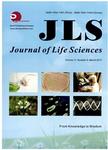Effect of Earthworms on Removal of Pathogens during Stabilization of Industrial Organics
Effect of Earthworms on Removal of Pathogens during Stabilization of Industrial Organics作者机构:Vermiculture Research Station Department of Zoology D.S. College (Dr BRA University) Aligarh 202001 UP India VKS Krishi Vigyan Kendra Dhaura Hasanganj Unnao 209851 UP India
出 版 物:《Journal of Life Sciences》 (生命科学(英文版))
年 卷 期:2011年第5卷第10期
页 面:794-800页
学科分类:090603[农学-临床兽医学] 083002[工学-环境工程] 0830[工学-环境科学与工程(可授工学、理学、农学学位)] 08[工学] 09[农学] 0906[农学-兽医学]
主 题:Vermicompost earthworm gut casting removal of pathogens industrial organics.
摘 要:To investigate feasibility of pathogen free industrial organics with higher agronomic value, the industrial organic wastes were subjected to vermistabilization. The body of earthworm work as "biofilter" and they can "purify" and also "disinfect" and "detoxify" municipal and industrial organics. The microbiomics of gut and cast of earthworm (Eisenia foetida Savigny) and their association with vermistabilization was studied to determine the microbial quantification in reactors (industrial organics). Worm were reared in five reactors viz. Sewage sludge (SS), Paper mill industry sludge (PS), Vegetable processing industry (VP), Tannery waste (TW) and Meat process industrial sludge (MP) for ninety days. The microbial load (Salmonella, Shigella, Escherichia, Mycobacterium, Streptococcus) in gut and cast, biomass, recovery of cast in different reactors were determined, periodically. The microbiomics of worms gut revealed the removal of Salmonella (12-18 × 10^8±0.02 to 0-4 × 10^3 + 0.05 CFU/g), Shigella (14-23 × 10^8 ± 0.04 to 0-4 × 10^3 ± 0.05 CFU/g), Escherichia (4-16 × 10^8 ± 0.02 to 0-4 × 10^2 ± 0.05 CFU/g), Mycobacterium (3-16 × 10^8 ± 0.02 to 0-3 × 10^2 ± 0.05 CFU/g), Streptococcus (6-16 × 10^8 ± 0.02 to 0-4 × 10^3 ± 0.05 CFU/g) during stabilization of industrial organics. Similarly, reduction in pathogens Salmonella (12-19 × 10^8 ± 0.02 to 0-8 ×10^3 ± 0.05 CFU/g), Shigella (7-20× 10^8 ± 0.04 to 0-2 ×10^3 ± 0.05 CFU/g), Escherichia (2-20 × 10^8 ± 0.02 to 0.0-2 × 10^3 ± 0.05), Mycobacterium (1-8 × 10^8 ±0.05 to 0.0-5 × 10^2 ± 0.05 CFU/g), Streptococcus (8-18 × 10^8 ± 0.02 to 0-7 × 10^3 ± 0.05 CFU/g) in castings of industrial organics indicates the selective nature of feeding of worm. This amply demonstrates that these pathogens have been eliminated as they entered in food chain of worms. However, it may not be possible to remove pathogens completely, but at least worms change the "microbial make-up" of industrial organics to make it harmless to the soil and enable its u



